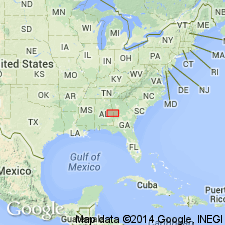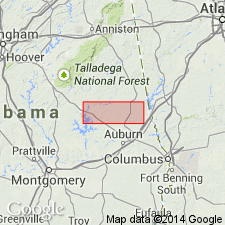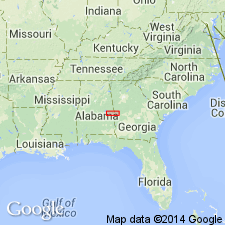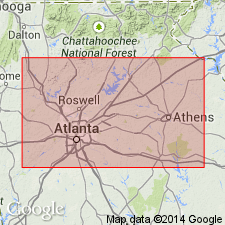
- Usage in publication:
-
- Opelika Complex
- Modifications:
-
- Named
- Dominant lithology:
-
- Gneiss
- Schist
- Amphibolite
- AAPG geologic province:
-
- Piedmont-Blue Ridge province
Summary:
Opelika Complex, a predominantly metasedimentary unit, named for town in Lee Co., Alabama. Occurs east-central AL and west-central Georgia. Complex includes Loachapoka Schist to the northwest, Auburn Gneiss to the southeast, and the intrusive Bottle granite. Age considered to be early Paleozoic.
Source: GNU records (USGS DDS-6; Reston GNULEX).

- Usage in publication:
-
- Opelika Complex
- Modifications:
-
- Revised
- AAPG geologic province:
-
- Piedmont-Blue Ridge province
Summary:
The Farmville granite of DeRatmiroff (1972) is herein elevated to formal lithodemic status as Farmville Metagranite of Opelika Complex. Unit replaces the here abandoned Bottle granite of Bentley and Neathery (1970). At the designated type locality in Lee Co., AL, unit is described as medium to coarse grained and well foliated by dimensionally aligned biotite and quartz. Reference localities 1.5 mi due west of Farmville Church and west of Auburn are representative of lesser deformed cores. Locally contains porphyroblasts of potassium feldspar and is commonly cut by narrow pegmatite veins. Numerous sills of the Farmville intrude the Auburn Gneiss and Loachapoka Schist. Synmetamorphic intrusion of the unit is indicated by 369+/-5 m.y. age (Rb-Sr isotopic data from Goldberg and Burnell, 1987) and later deformation by 295+/-4 m.y. age (Rb-Sr mineral isochron from Goldberg and Steltenpohl, 1988). Emplacement age, therefore, is Late Devonian (Acadian).
Source: GNU records (USGS DDS-6; Reston GNULEX).

- Usage in publication:
-
- Opelika Complex*
- Modifications:
-
- Overview
- Age modified
- AAPG geologic province:
-
- Piedmont-Blue Ridge province
Summary:
Inner Piedmont is divided into two groups of rocks, Dadeville and Opelika Complexes (Bentley and Neathery, 1970), divided by Stonewall line. Dadeville Complex consists of Agricola Schist, Waresville Schist, Camp Hill Gneiss, Chattasofka Creek Gneiss, Ropes Creek Amphibolite, Waverly Gneiss, Simmons Crossroads metagranite (informal), and various unnamed mafic and ultramafic intrusive rocks. Opelika Complex consists of Loachapoka Schist, Saugahatchee quartzite, and Auburn Gneiss and schist. Farmville Metagranite intrudes these units. Age of all Inner Piedmont rocks is early Paleozoic. Report includes geologic sketch map.
[Remark reflects usage as published, not as reviewed in draft form. Although GNU review requested informal terms to be inverted, the published version shows that authors did not comply with request. Whatley Mill is misspelled as Whatley Mills in published version; error introduced after GNU review. (GNU records, USGS DDS-6; Reston GNULEX 01/21/94)]
Source: GNU records (USGS DDS-6; Reston GNULEX).

- Usage in publication:
-
- Opelika Complex*
- Modifications:
-
- Age modified
- AAPG geologic province:
-
- Piedmont-Blue Ridge province
Summary:
Recent geologic mapping, petrographic and geochemical studies, and some geochronological data of rocks called Lithonia Gneiss, Mount Arabia migmatite within Lithonia Gneiss around Mount Arabia, Odessadale Gneiss in central GA, and Farmville Metagranite of Opelika Complex in eastern AL have shown that 1) they are part of the same complex unit, 2) that several textural varieties are common to all of them in outcrop, 3) that they all occupy the same structural or stratigraphic interval, 4) that they have approximately the same mineral and chemical compositions, and 5) that their ages range between about 380 to 360 Ma (Middle to Late Devonian). Because of uncertainties in Pb-U zircon age data, because Rb-Sr and K-Ar ages could have been affected by metamorphism, and because overall sampling has been limited, all the gneisses are assigned an Ordovician to Devonian age.
Source: GNU records (USGS DDS-6; Reston GNULEX).
For more information, please contact Nancy Stamm, Geologic Names Committee Secretary.
Asterisk (*) indicates published by U.S. Geological Survey authors.
"No current usage" (†) implies that a name has been abandoned or has fallen into disuse. Former usage and, if known, replacement name given in parentheses ( ).
Slash (/) indicates name conflicts with nomenclatural guidelines (CSN, 1933; ACSN, 1961, 1970; NACSN, 1983, 2005, 2021). May be explained within brackets ([ ]).

